Infrastructure Deterioration Modelling: A Civil Engineering Report
VerifiedAdded on 2023/01/19
|10
|1400
|48
Report
AI Summary
This report examines infrastructure deterioration modeling, specifically focusing on a concrete pile system experiencing spalling due to chloride-induced corrosion. The investigation involves determining chloride concentration using the Volhard method and X-ray fluorescence spectrometry, alongside half-cell potential measurements to assess corrosion severity. The report then explores the selection of appropriate repair materials, considering factors such as equipment availability, shelf life, and cost. Various repair methods are discussed, including epoxy-sand mortar, shotcrete, and polymer-modified concretes. The report emphasizes the importance of material properties unaffected by chloride for new pile designs. The conclusion highlights the need for engineers to prioritize durability and environmental performance in concrete infrastructure, despite the simplicity and cost preferences in construction.
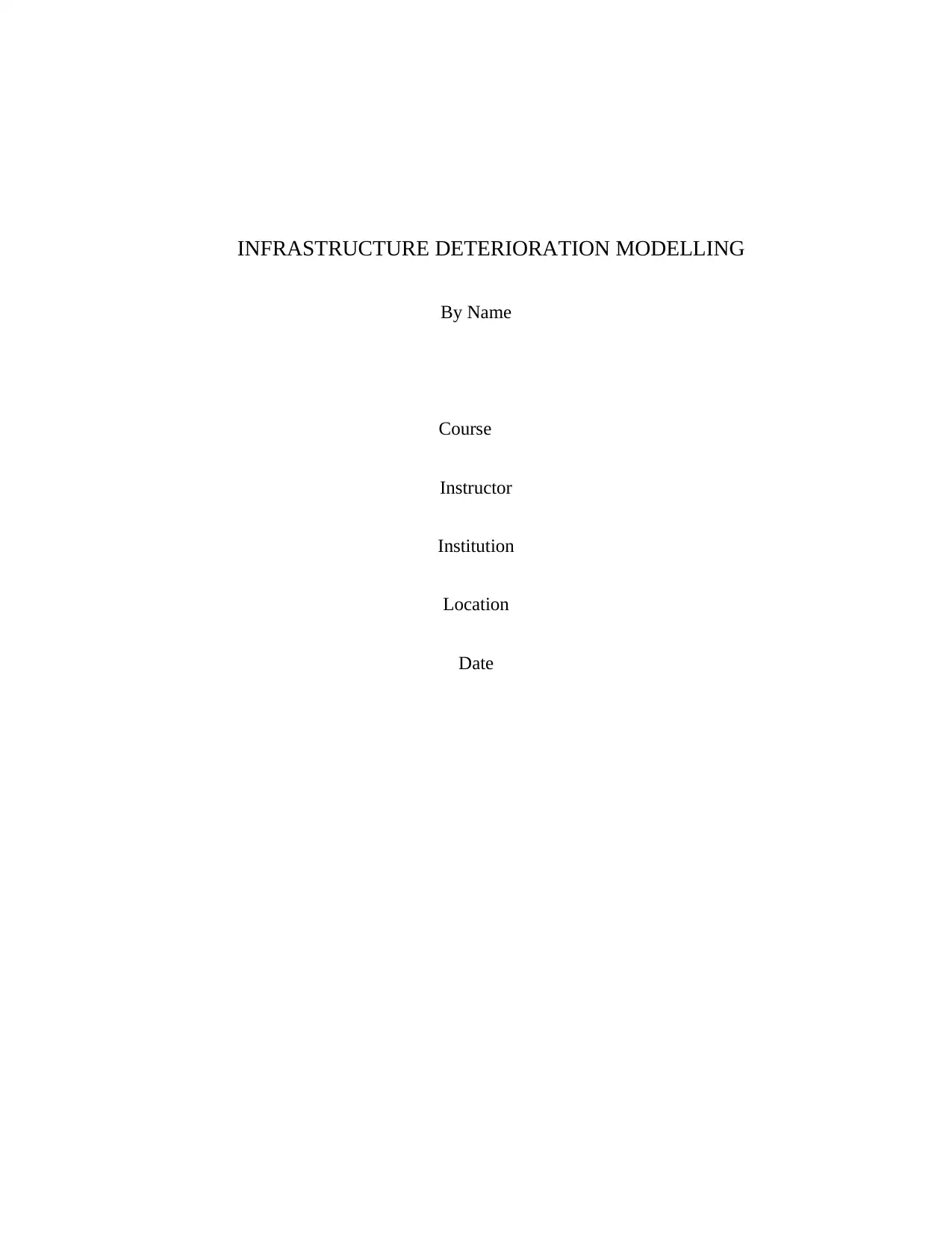
INFRASTRUCTURE DETERIORATION MODELLING
By Name
Course
Instructor
Institution
Location
Date
By Name
Course
Instructor
Institution
Location
Date
Paraphrase This Document
Need a fresh take? Get an instant paraphrase of this document with our AI Paraphraser
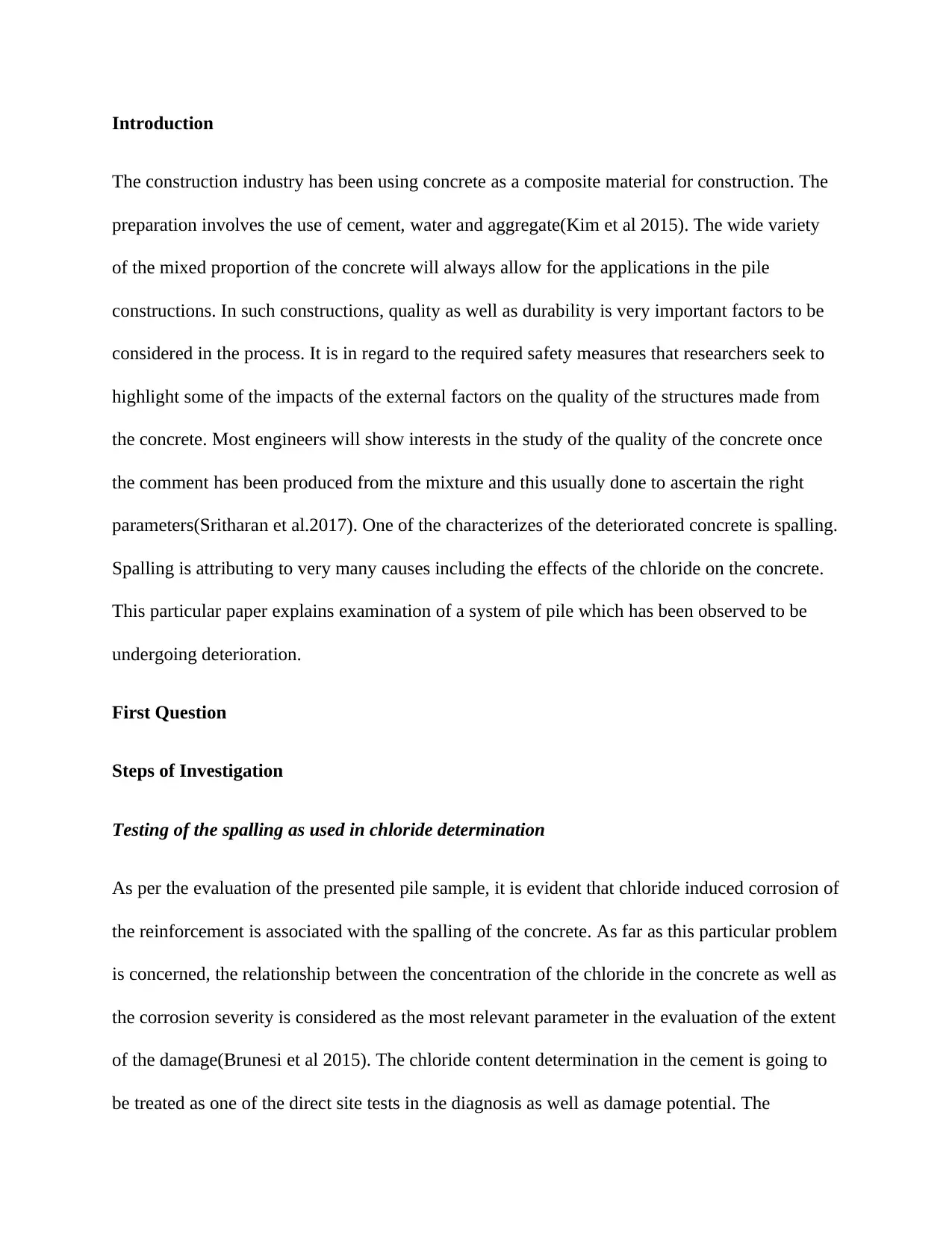
Introduction
The construction industry has been using concrete as a composite material for construction. The
preparation involves the use of cement, water and aggregate(Kim et al 2015). The wide variety
of the mixed proportion of the concrete will always allow for the applications in the pile
constructions. In such constructions, quality as well as durability is very important factors to be
considered in the process. It is in regard to the required safety measures that researchers seek to
highlight some of the impacts of the external factors on the quality of the structures made from
the concrete. Most engineers will show interests in the study of the quality of the concrete once
the comment has been produced from the mixture and this usually done to ascertain the right
parameters(Sritharan et al.2017). One of the characterizes of the deteriorated concrete is spalling.
Spalling is attributing to very many causes including the effects of the chloride on the concrete.
This particular paper explains examination of a system of pile which has been observed to be
undergoing deterioration.
First Question
Steps of Investigation
Testing of the spalling as used in chloride determination
As per the evaluation of the presented pile sample, it is evident that chloride induced corrosion of
the reinforcement is associated with the spalling of the concrete. As far as this particular problem
is concerned, the relationship between the concentration of the chloride in the concrete as well as
the corrosion severity is considered as the most relevant parameter in the evaluation of the extent
of the damage(Brunesi et al 2015). The chloride content determination in the cement is going to
be treated as one of the direct site tests in the diagnosis as well as damage potential. The
The construction industry has been using concrete as a composite material for construction. The
preparation involves the use of cement, water and aggregate(Kim et al 2015). The wide variety
of the mixed proportion of the concrete will always allow for the applications in the pile
constructions. In such constructions, quality as well as durability is very important factors to be
considered in the process. It is in regard to the required safety measures that researchers seek to
highlight some of the impacts of the external factors on the quality of the structures made from
the concrete. Most engineers will show interests in the study of the quality of the concrete once
the comment has been produced from the mixture and this usually done to ascertain the right
parameters(Sritharan et al.2017). One of the characterizes of the deteriorated concrete is spalling.
Spalling is attributing to very many causes including the effects of the chloride on the concrete.
This particular paper explains examination of a system of pile which has been observed to be
undergoing deterioration.
First Question
Steps of Investigation
Testing of the spalling as used in chloride determination
As per the evaluation of the presented pile sample, it is evident that chloride induced corrosion of
the reinforcement is associated with the spalling of the concrete. As far as this particular problem
is concerned, the relationship between the concentration of the chloride in the concrete as well as
the corrosion severity is considered as the most relevant parameter in the evaluation of the extent
of the damage(Brunesi et al 2015). The chloride content determination in the cement is going to
be treated as one of the direct site tests in the diagnosis as well as damage potential. The
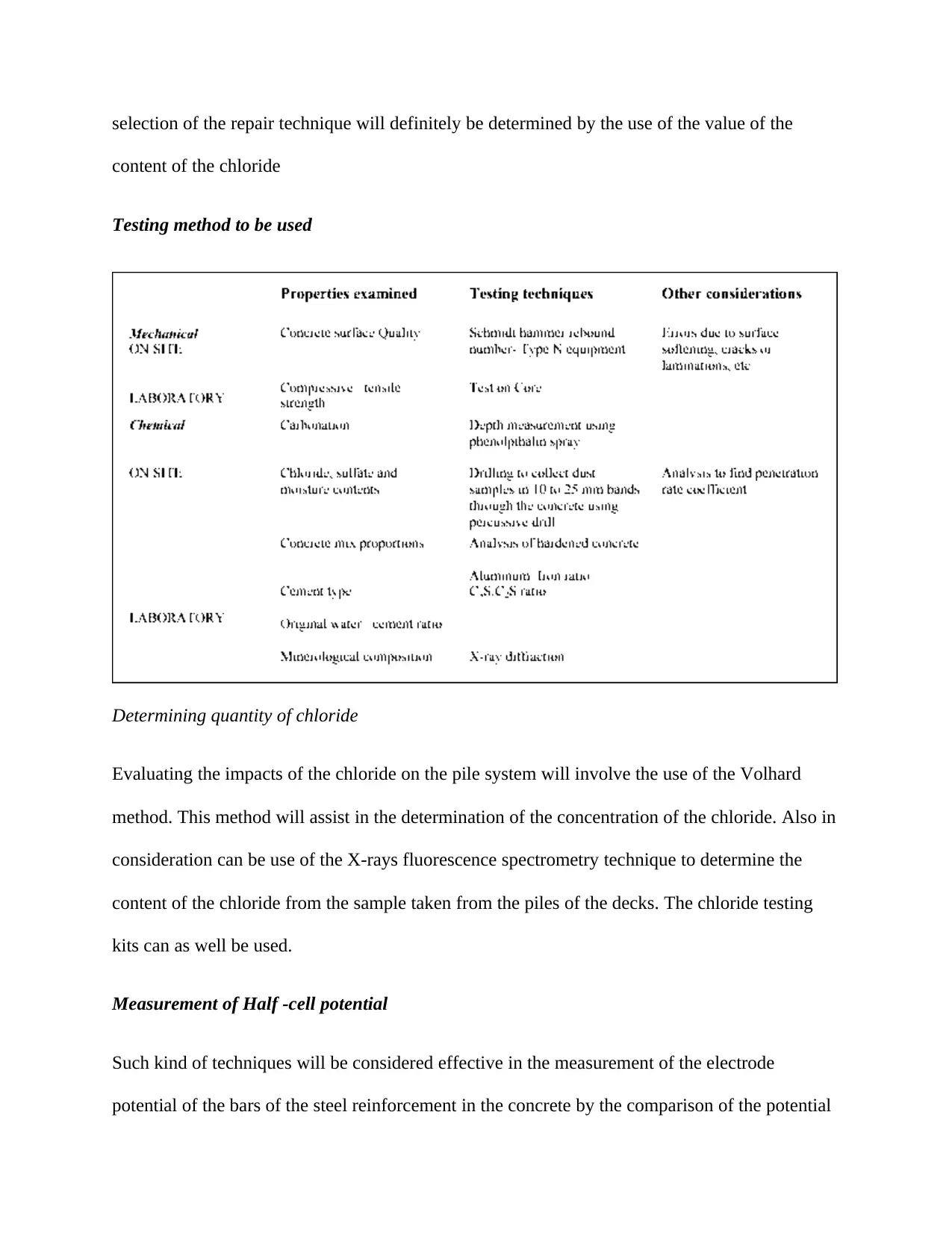
selection of the repair technique will definitely be determined by the use of the value of the
content of the chloride
Testing method to be used
Determining quantity of chloride
Evaluating the impacts of the chloride on the pile system will involve the use of the Volhard
method. This method will assist in the determination of the concentration of the chloride. Also in
consideration can be use of the X-rays fluorescence spectrometry technique to determine the
content of the chloride from the sample taken from the piles of the decks. The chloride testing
kits can as well be used.
Measurement of Half -cell potential
Such kind of techniques will be considered effective in the measurement of the electrode
potential of the bars of the steel reinforcement in the concrete by the comparison of the potential
content of the chloride
Testing method to be used
Determining quantity of chloride
Evaluating the impacts of the chloride on the pile system will involve the use of the Volhard
method. This method will assist in the determination of the concentration of the chloride. Also in
consideration can be use of the X-rays fluorescence spectrometry technique to determine the
content of the chloride from the sample taken from the piles of the decks. The chloride testing
kits can as well be used.
Measurement of Half -cell potential
Such kind of techniques will be considered effective in the measurement of the electrode
potential of the bars of the steel reinforcement in the concrete by the comparison of the potential
⊘ This is a preview!⊘
Do you want full access?
Subscribe today to unlock all pages.

Trusted by 1+ million students worldwide
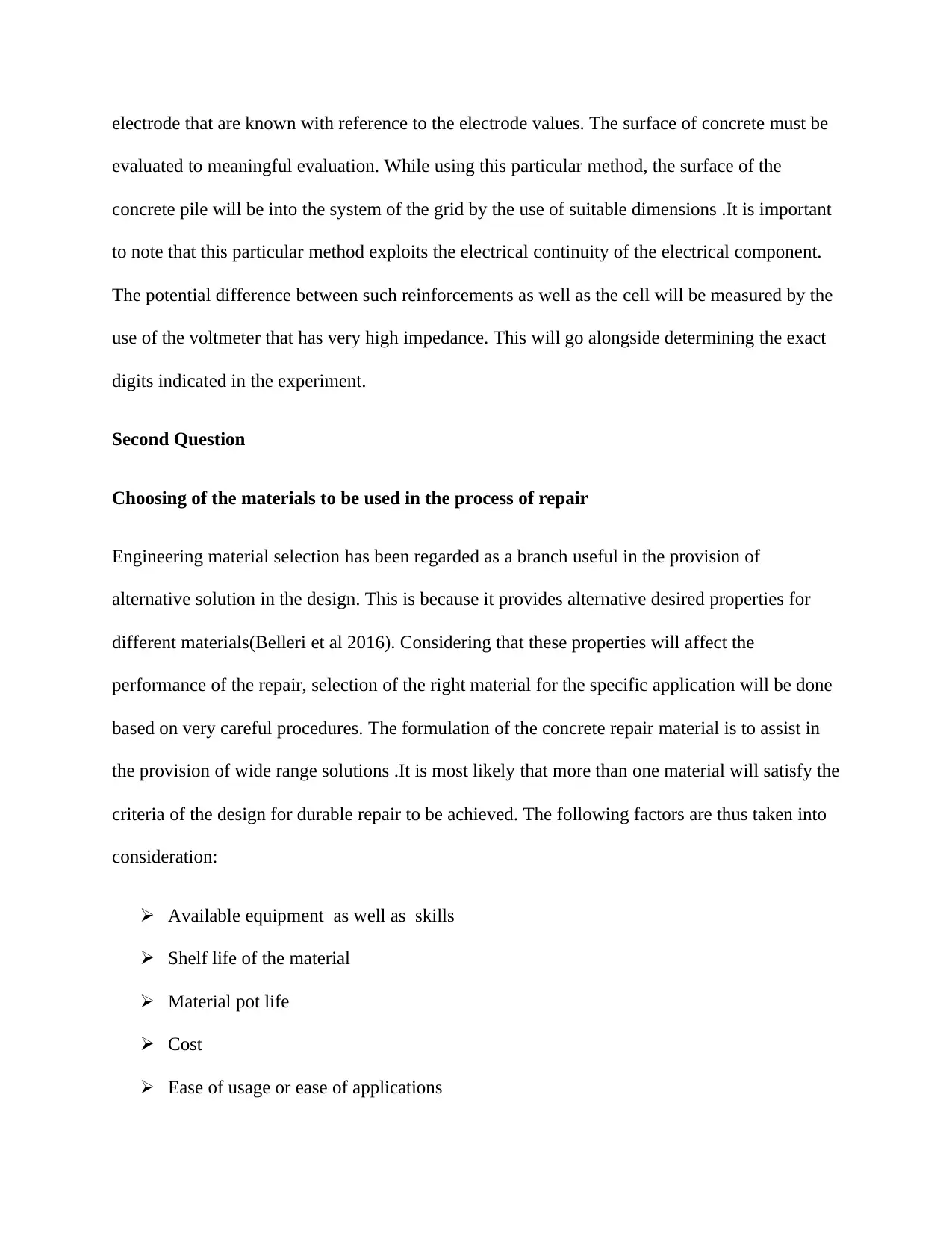
electrode that are known with reference to the electrode values. The surface of concrete must be
evaluated to meaningful evaluation. While using this particular method, the surface of the
concrete pile will be into the system of the grid by the use of suitable dimensions .It is important
to note that this particular method exploits the electrical continuity of the electrical component.
The potential difference between such reinforcements as well as the cell will be measured by the
use of the voltmeter that has very high impedance. This will go alongside determining the exact
digits indicated in the experiment.
Second Question
Choosing of the materials to be used in the process of repair
Engineering material selection has been regarded as a branch useful in the provision of
alternative solution in the design. This is because it provides alternative desired properties for
different materials(Belleri et al 2016). Considering that these properties will affect the
performance of the repair, selection of the right material for the specific application will be done
based on very careful procedures. The formulation of the concrete repair material is to assist in
the provision of wide range solutions .It is most likely that more than one material will satisfy the
criteria of the design for durable repair to be achieved. The following factors are thus taken into
consideration:
Available equipment as well as skills
Shelf life of the material
Material pot life
Cost
Ease of usage or ease of applications
evaluated to meaningful evaluation. While using this particular method, the surface of the
concrete pile will be into the system of the grid by the use of suitable dimensions .It is important
to note that this particular method exploits the electrical continuity of the electrical component.
The potential difference between such reinforcements as well as the cell will be measured by the
use of the voltmeter that has very high impedance. This will go alongside determining the exact
digits indicated in the experiment.
Second Question
Choosing of the materials to be used in the process of repair
Engineering material selection has been regarded as a branch useful in the provision of
alternative solution in the design. This is because it provides alternative desired properties for
different materials(Belleri et al 2016). Considering that these properties will affect the
performance of the repair, selection of the right material for the specific application will be done
based on very careful procedures. The formulation of the concrete repair material is to assist in
the provision of wide range solutions .It is most likely that more than one material will satisfy the
criteria of the design for durable repair to be achieved. The following factors are thus taken into
consideration:
Available equipment as well as skills
Shelf life of the material
Material pot life
Cost
Ease of usage or ease of applications
Paraphrase This Document
Need a fresh take? Get an instant paraphrase of this document with our AI Paraphraser
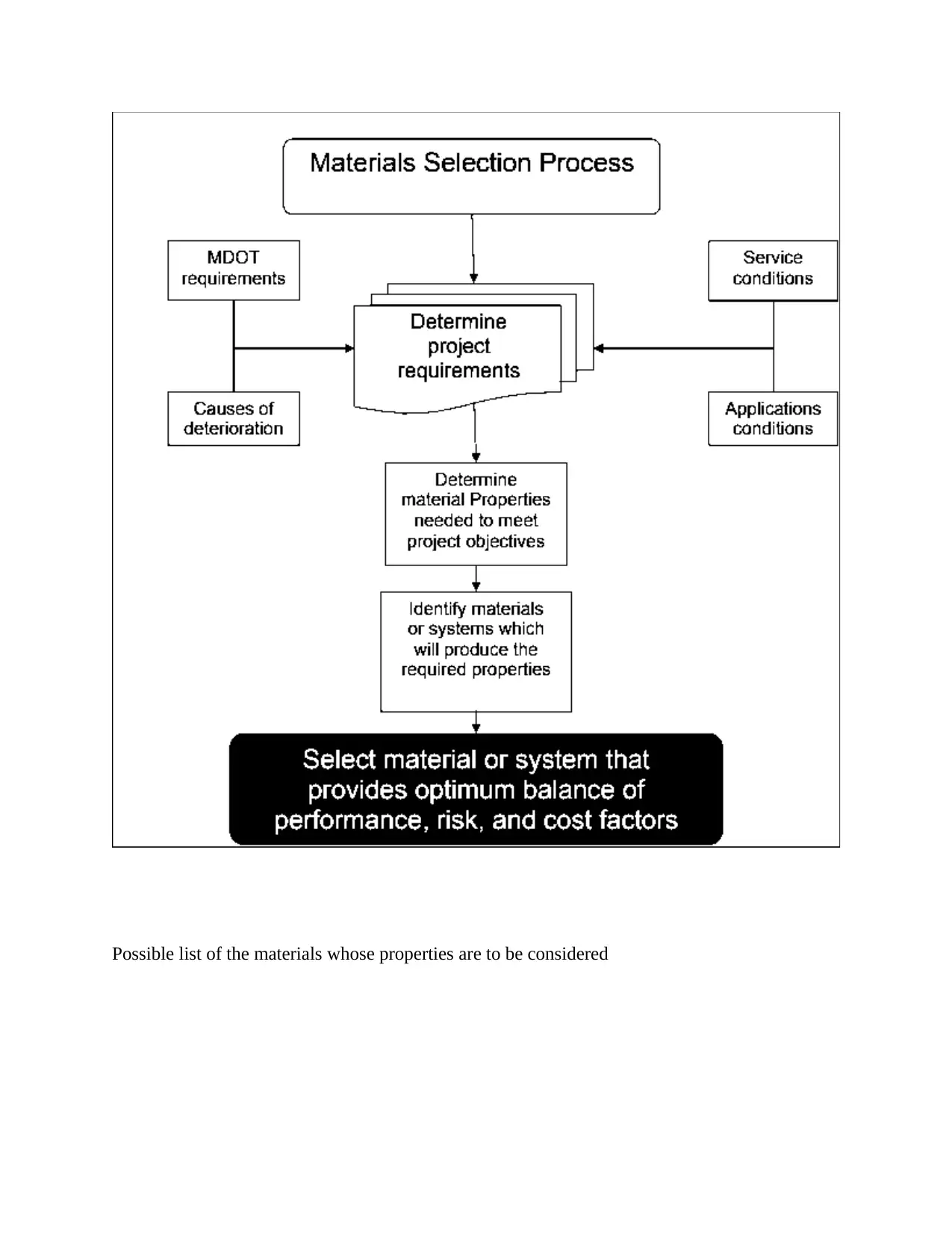
Possible list of the materials whose properties are to be considered
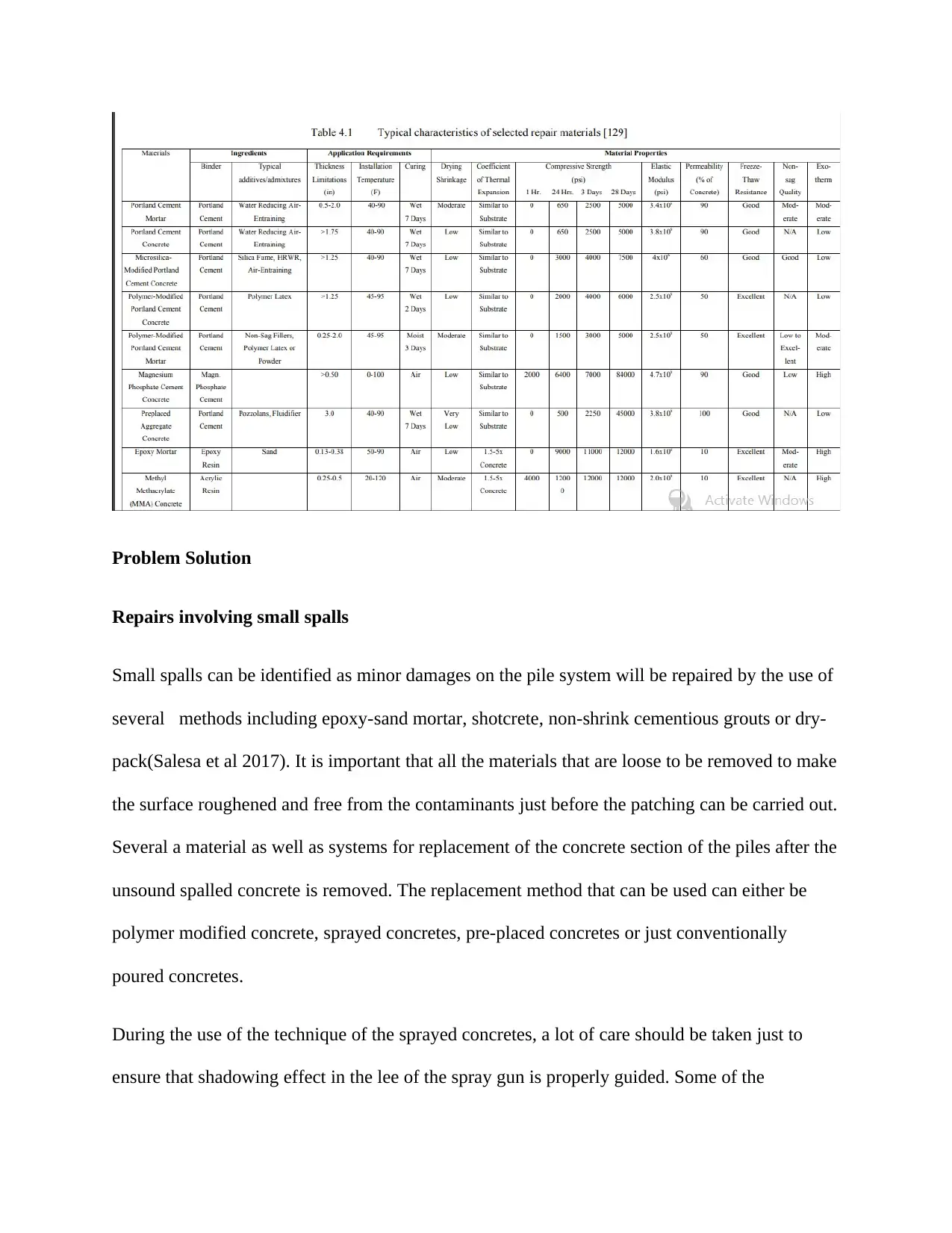
Problem Solution
Repairs involving small spalls
Small spalls can be identified as minor damages on the pile system will be repaired by the use of
several methods including epoxy-sand mortar, shotcrete, non-shrink cementious grouts or dry-
pack(Salesa et al 2017). It is important that all the materials that are loose to be removed to make
the surface roughened and free from the contaminants just before the patching can be carried out.
Several a material as well as systems for replacement of the concrete section of the piles after the
unsound spalled concrete is removed. The replacement method that can be used can either be
polymer modified concrete, sprayed concretes, pre-placed concretes or just conventionally
poured concretes.
During the use of the technique of the sprayed concretes, a lot of care should be taken just to
ensure that shadowing effect in the lee of the spray gun is properly guided. Some of the
Repairs involving small spalls
Small spalls can be identified as minor damages on the pile system will be repaired by the use of
several methods including epoxy-sand mortar, shotcrete, non-shrink cementious grouts or dry-
pack(Salesa et al 2017). It is important that all the materials that are loose to be removed to make
the surface roughened and free from the contaminants just before the patching can be carried out.
Several a material as well as systems for replacement of the concrete section of the piles after the
unsound spalled concrete is removed. The replacement method that can be used can either be
polymer modified concrete, sprayed concretes, pre-placed concretes or just conventionally
poured concretes.
During the use of the technique of the sprayed concretes, a lot of care should be taken just to
ensure that shadowing effect in the lee of the spray gun is properly guided. Some of the
⊘ This is a preview!⊘
Do you want full access?
Subscribe today to unlock all pages.

Trusted by 1+ million students worldwide

advantages of this particular method are that it will be possible to produce high strength concrete
with low permeability even without the use of the formwork. Such moves are very important for
the repairs which are carried out of the slabs and beam. Used in the process of the construction
Third Question
In order to properly address the issue of the spalling, the new technique of the new pile should
take into consideration the properties of the materials that are never affected by the chloride.
From the information given, the measure strength of the concrete is 32 MPa with the concrete
being 320 kg/m3. This implies that the design will the allowable load as 32mpa(Ameli et al
2015).
This will take into consideration the following:
Bond strength of the component
Allowable load considerations as well
Tensile stress
Calculation process
with low permeability even without the use of the formwork. Such moves are very important for
the repairs which are carried out of the slabs and beam. Used in the process of the construction
Third Question
In order to properly address the issue of the spalling, the new technique of the new pile should
take into consideration the properties of the materials that are never affected by the chloride.
From the information given, the measure strength of the concrete is 32 MPa with the concrete
being 320 kg/m3. This implies that the design will the allowable load as 32mpa(Ameli et al
2015).
This will take into consideration the following:
Bond strength of the component
Allowable load considerations as well
Tensile stress
Calculation process
Paraphrase This Document
Need a fresh take? Get an instant paraphrase of this document with our AI Paraphraser
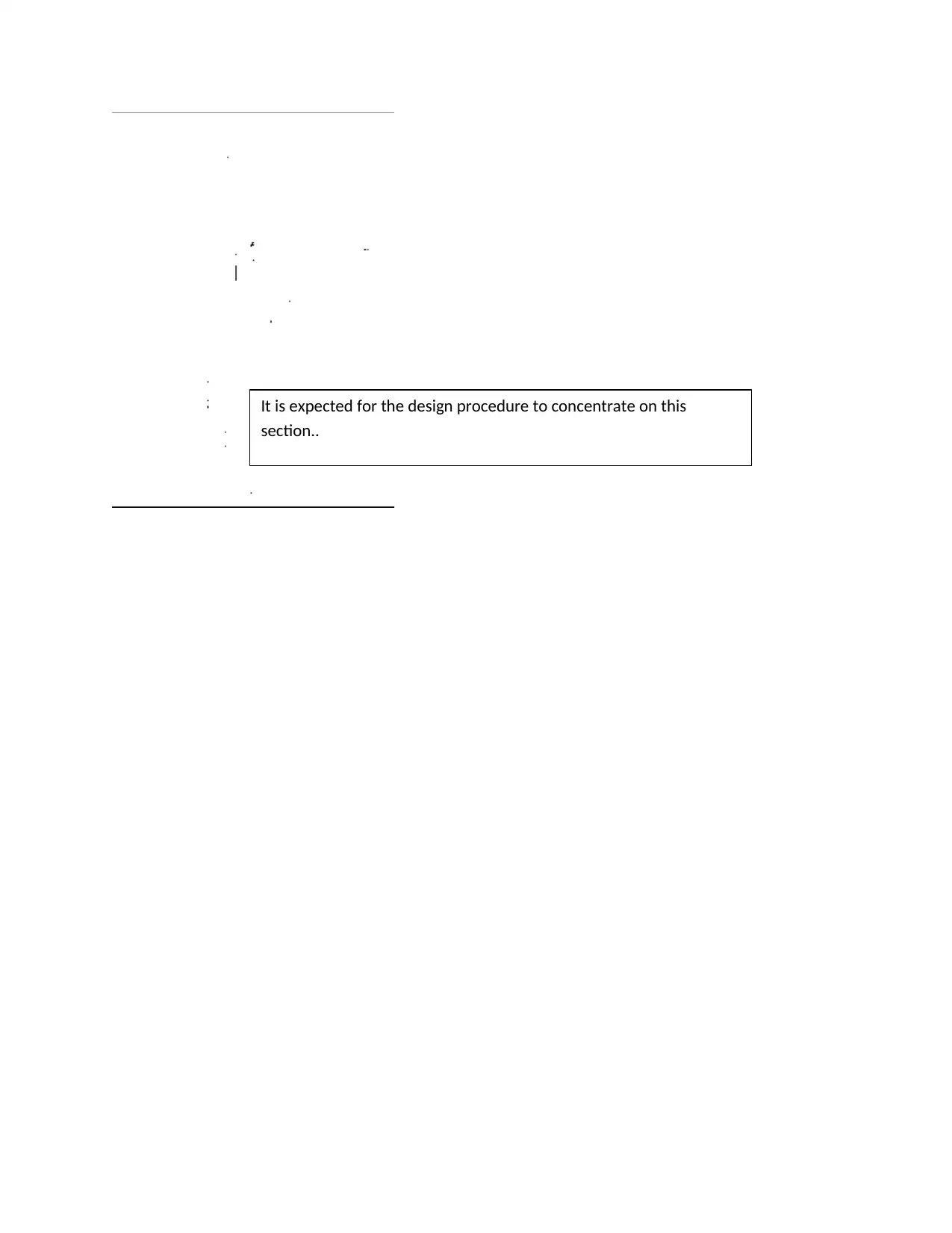
It is expected for the design procedure to concentrate on this
section..
section..
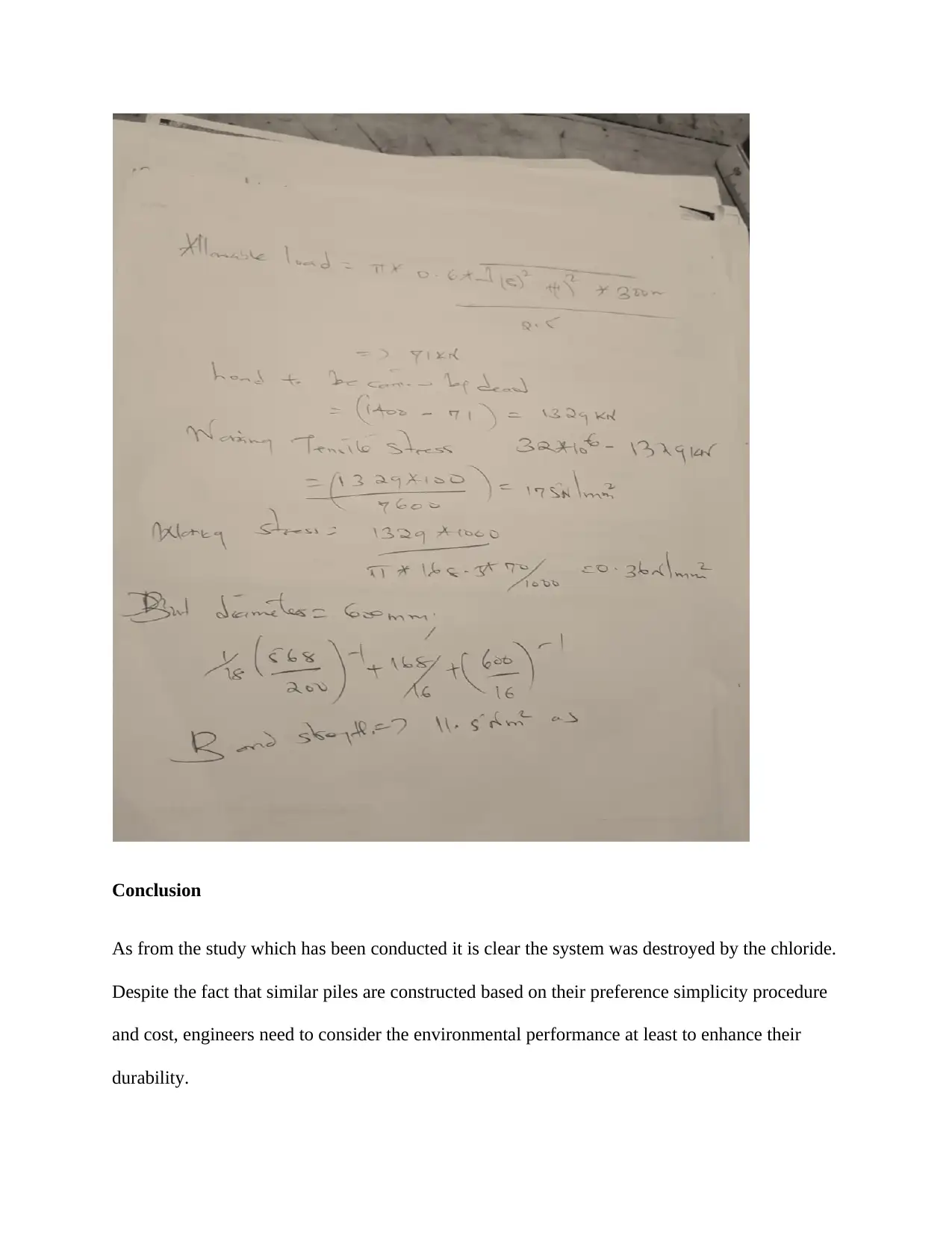
Conclusion
As from the study which has been conducted it is clear the system was destroyed by the chloride.
Despite the fact that similar piles are constructed based on their preference simplicity procedure
and cost, engineers need to consider the environmental performance at least to enhance their
durability.
As from the study which has been conducted it is clear the system was destroyed by the chloride.
Despite the fact that similar piles are constructed based on their preference simplicity procedure
and cost, engineers need to consider the environmental performance at least to enhance their
durability.
⊘ This is a preview!⊘
Do you want full access?
Subscribe today to unlock all pages.

Trusted by 1+ million students worldwide

References
Ameli, M.J., Parks, J.E., Brown, D.N. and Pantelides, C.P., 2015. Seismic evaluation of grouted
splice sleeve connections for reinforced precast concrete column–to–cap beam joints in
accelerated bridge construction Date: March-April 2015.
Belleri, A., Torquati, M., Marini, A. and Riva, P., 2016. Horizontal cladding panels: in-plane
seismic performance in precast concrete buildings. Bulletin of Earthquake
Engineering, 14(4), pp.1103-1129.
Brunesi, E., Nascimbene, R., Bolognini, D. and Bellotti, D., 2015. Experimental investigation of
the cyclic response of reinforced precast concrete framed structures. PCI Journal, 60(2),
pp.57-79.
Kim, M.K., Cheng, J.C., Sohn, H. and Chang, C.C., 2015. A framework for dimensional and
surface quality assessment of precast concrete elements using BIM and 3D laser
scanning. Automation in Construction, 49, pp.225-238.
Salesa, Á., Pérez-Benedicto, J.A., Colorado-Aranguren, D., López-Julián, P.L., Esteban, L.M.,
Sanz-Baldúz, L.J., Sáez-Hostaled, J.L., Ramis, J. and Olivares, D., 2017. Physico–
mechanical properties of multi–recycled concrete from precast concrete industry. Journal
of cleaner production, 141, pp.248-255.
Sritharan, S., Aaleti, S., Henry, R.S., Liu, K.Y. and Tsai, K.C., 2015. Precast concrete wall with
end columns (PreWEC) for earthquake resistant design. Earthquake Engineering &
Structural Dynamics, 44(12), pp.2075-2092.
Ameli, M.J., Parks, J.E., Brown, D.N. and Pantelides, C.P., 2015. Seismic evaluation of grouted
splice sleeve connections for reinforced precast concrete column–to–cap beam joints in
accelerated bridge construction Date: March-April 2015.
Belleri, A., Torquati, M., Marini, A. and Riva, P., 2016. Horizontal cladding panels: in-plane
seismic performance in precast concrete buildings. Bulletin of Earthquake
Engineering, 14(4), pp.1103-1129.
Brunesi, E., Nascimbene, R., Bolognini, D. and Bellotti, D., 2015. Experimental investigation of
the cyclic response of reinforced precast concrete framed structures. PCI Journal, 60(2),
pp.57-79.
Kim, M.K., Cheng, J.C., Sohn, H. and Chang, C.C., 2015. A framework for dimensional and
surface quality assessment of precast concrete elements using BIM and 3D laser
scanning. Automation in Construction, 49, pp.225-238.
Salesa, Á., Pérez-Benedicto, J.A., Colorado-Aranguren, D., López-Julián, P.L., Esteban, L.M.,
Sanz-Baldúz, L.J., Sáez-Hostaled, J.L., Ramis, J. and Olivares, D., 2017. Physico–
mechanical properties of multi–recycled concrete from precast concrete industry. Journal
of cleaner production, 141, pp.248-255.
Sritharan, S., Aaleti, S., Henry, R.S., Liu, K.Y. and Tsai, K.C., 2015. Precast concrete wall with
end columns (PreWEC) for earthquake resistant design. Earthquake Engineering &
Structural Dynamics, 44(12), pp.2075-2092.
1 out of 10
Related Documents
Your All-in-One AI-Powered Toolkit for Academic Success.
+13062052269
info@desklib.com
Available 24*7 on WhatsApp / Email
![[object Object]](/_next/static/media/star-bottom.7253800d.svg)
Unlock your academic potential
Copyright © 2020–2025 A2Z Services. All Rights Reserved. Developed and managed by ZUCOL.





